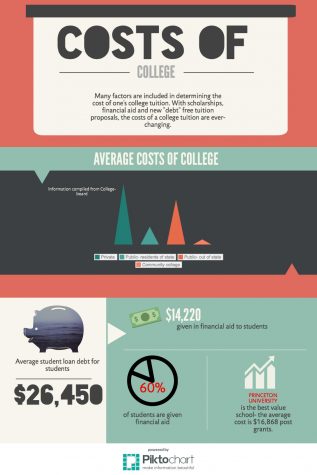Staffers debate the idea of free college tuition

College can be expensive, but there are pros and cons to providing free college tuition.

“Free” college comes at a high cost
Sasha Milbeck
Currently, a new debate has sparked about the cost of attending college and the resulting debt that students and their families incur. Yet, there is way more to the affordability of college than lower prices.
For me, a high school student who will soon be attending college, calls to reduce tuition sound terrific. However, the recent proposals to completely eliminate college tuition have severe consequences.
“Making college free for everyone would almost certainly mean giving far more money to students from richer families than poorer ones,” reporter Matt Bruenig said.
Further elaborating on this claim, Catharine Hill, op-ed contributor, added that “no recent proposals for reform would sufficiently target the students most affected by rising college costs and debt burdens: those from middle- and low-income backgrounds. To get those students to and through college, we must focus on what they are asked to pay, not on making it free for everyone.”
According to College Board, last year, the average cost of college was $9,139 at a public four-year school and $31,231 at a private non-profit school. Any policy reducing college costs to zero would inevitably benefit the students whose families earn the most, and those who currently pay all of or the majority of the school’s full tuition price, simply because they can afford to. Lowering tuition would have less of an impact on the students that it was meant to help because low-income students already receive need-based financial aid grants that reduce the costs of college.
“If free tuition weren’t an indiscriminate solution, it might be a worthwhile plan. But if our real goal is to improve college access and affordability for students from low-income families, as it should be, stronger need-based financial aid policies and well-structured borrowing are a far better strategy,” Hill said.
Besides the aforementioned reasons, having free college would only hurt students and their families in the long run; our society would be seeing the effects of debt later in life when taxes are raised exponentially to pay for the “free” college plan. While students would see their education as “free,” taxpayers would ultimately have to pay much more in order to sustain the implementation of this policy.
The new policy for free college would “increase taxes on the wealthy and on corporations to pay the basic cost of educating all students, rich and poor. Superficially, it’s an appealing idea, but it would be counterproductive to increase taxes to enable students from well-off families to attend college for free. Zeroing out tuition nationally would require tripling public funding for most state colleges and universities. It is entirely unrealistic to believe that taxes would be increased enough to provide that funding. The share for return to aid would certainly drop and probably disappear, defunding low income students,” Robert Birgeneau, politics and law professor at University of Berkeley, said.
Rather than eliminating all the costs of college, higher emphasis should be placed on financial aid grants to truly help those who cannot afford education on their own.
“Given the best of all possible worlds… I would place more emphasis on increasing the amount of funding that goes into programs like Pell Grants, which purely and simply award funds to students who really cannot afford full tuition,” Charles Vest, former Massachusetts Institute of Technology president, said.
College should be debt free
Hannah O’Leary
College tuition has increased by 1,120 percent since 1978, and the dismal outlook for debt-burdened students should encourage the U.S. to pursue a higher education system that is debt-free.
According to Global Higher Education Rankings, with an average tuition cost of $13,856 as of 2010, the U.S. has the most expensive higher education system in the entire world. These astronomical costs force students to take out loans to pay for college, which, in turn, means that college students leave school with extremely large amounts of debt. The average amount of debt that a student graduates with is $28,950, according to a study conducted by The Institute for College Access and Success. The same source proved that between 2004 and 2014, the “average debt at graduation rose at more than twice the rate of inflation.”
While studies show that this amount of debt is manageable for the average college graduate, it still does not allow that student to prosper and live a financially balanced life once he or she graduates from school. If students came out of college debt free, they would be able to invest their money or to purchase large items like cars and homes, both of which stimulate the economy to far greater extents than repaying student loans does. College graduates are not able to fully participate in the global economy due to their monthly payments for their student loan debt.
All of this is assuming that any given college graduate can actually find a job that pays well enough to pay off his or her loans once he or she graduates, or that he or she can even a job at all. However, the truth is that many recent college graduates are only able to obtain entry-level positions that do not pay well enough to allow them to create a financially successful future while still paying off student loans. These graduates must pay off loans before they can even think about saving money or investing it.
While the burden of debt is heavy on college graduates, it is much heavier on college dropouts. It is estimated that 30 percent of people with college loans, a substantial portion of the population, drop out of school. With no degree in hand, these people have a nearly impossible time finding a job that allows them to pay off their debt while maintaining a reasonably comfortable standard of living.
The most substantial benefit that the country may see, however, is an increase in attendance of low-income students. Studies have found “nationally representative data that indicates that qualified and talented students who are concerned about rising college prices are 12 to 16 times more likely to forgo college altogether,” Sara Goldrick-Rab, a researcher on the effects of two-year colleges on the populace at the University of Wisconsin, said. Low-income students are not going to college because they cannot afford it and, more likely, are not willing to risk financial ruin in the chances that they will not be able to find a job after they graduate from school. The reason that these students are not attending college is not that they are lazy or under performing; many of these students are well qualified and extremely willing to attend college.
While the practice of debt-free college may produce more graduates, and therefore more competition for an already limited number of jobs, this competition will breed success. With more qualified applicants per open position, the employer will have a greater pool to choose from, and this phenomenon will force applicants to become even more competitive in their resumé by having an even broader and deeper range of skills.
There should still be a competitive university admissions process in order to keep the number of graduates in check and thus maintain the value of a bachelor’s degree. “Schools should still be allowed to reject students who are not qualified enough, but that should be the barrier to college, not the cost of it,” Lauren Grant, junior, said. The cost of college should not be the barrier that keeps many qualified students from attending an institution of higher learning.
A change like this in our society could only improve it. As a country, we could produce more scientists, engineers, entrepreneurs, authors, app-developers and many other jobs. The influx of all these people into the workforce creates a more innovative society and a greater amount of high-quality goods and services.
Also, there’s the fact that a greater percentage of the population will be well educated. As a country, the U.S. cannot afford to leave a significant part of its population so poorly educated. Eliminating the debt barrier to college is the first step in the long process of educating the populace in order to create a more innovative future.

Sasha Milbeck is the senior Editor-in-Chief of Highlander Publications. Sasha is a self-diagnosed fontaholic and could spend all day in Room 405 if she...

Hannah O'Leary a senior who finds herself as the editor-in-chief of Highlander Publications. Hannah loves designing magazine spreads, but finds that she...










